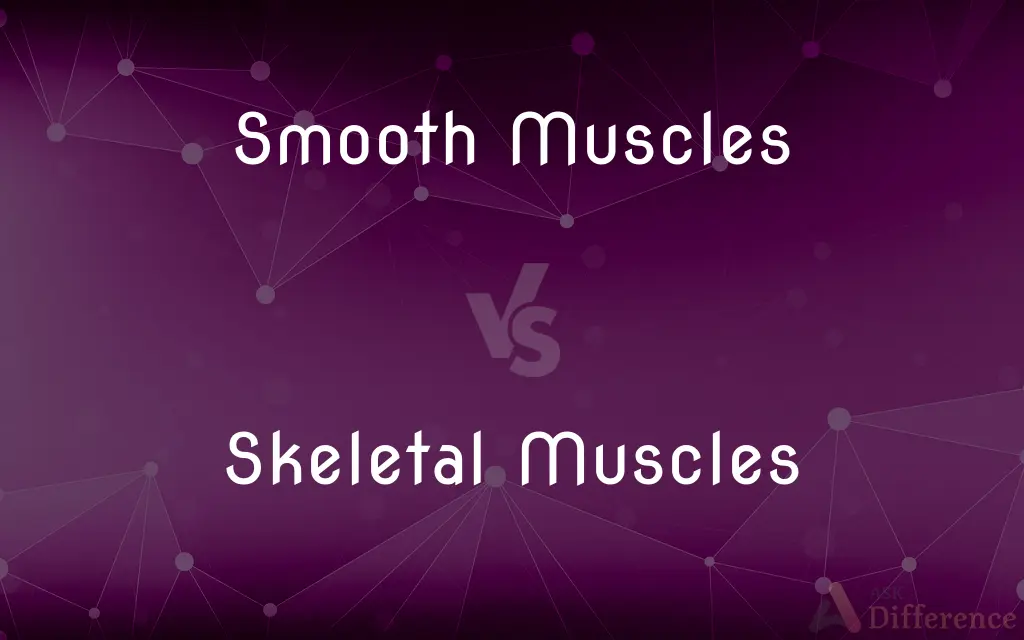Smooth Muscles vs. Skeletal Muscles — What's the Difference?
By Tayyaba Rehman — Published on November 10, 2023
Smooth Muscles are involuntary and found in organs, while Skeletal Muscles are voluntary and attached to bones.

Difference Between Smooth Muscles and Skeletal Muscles
Table of Contents
ADVERTISEMENT
Key Differences
Smooth Muscles play a pivotal role in the function of our internal organs. Unlike Skeletal Muscles, they operate autonomously without our conscious control. This ensures that essential processes like digestion or blood vessel constriction happen without deliberate thought. On the other hand, Skeletal Muscles are largely responsible for our body's movement, functioning under conscious control.
In terms of structure, Smooth Muscles are not striated and appear smooth under a microscope, hence their name. Contrarily, Skeletal Muscles showcase a striated or banded appearance due to their organized sarcomeres. This structural difference mirrors their functional roles: Smooth Muscles contract slowly and sustainably, while Skeletal Muscles can contract rapidly and powerfully.
The location of Smooth Muscles is primarily within the walls of hollow internal organs such as the stomach or intestines. In contrast, Skeletal Muscles are predominantly attached to bones via tendons, facilitating movement of the skeleton. This attachment enables precise control over our body's movements, from walking to intricate hand motions.
An interesting point to consider is the regeneration capability of these muscles. Smooth Muscles possess a greater capacity to regenerate compared to Skeletal Muscles. Any damage to Skeletal Muscles often results in scar tissue, whereas Smooth Muscles can heal more seamlessly.
Comparison Chart
Volition
Involuntary.
Voluntary.
ADVERTISEMENT
Appearance
Non-striated (smooth).
Striated (banded).
Location
Walls of internal organs.
Attached to bones via tendons.
Contraction Speed
Slow and sustained.
Rapid and powerful.
Regeneration Capability
Better regenerative ability.
Scar tissue formation with damage.
Compare with Definitions
Smooth Muscles
Smooth Muscles are found within internal organs.
The stomach's movements are due to its Smooth Muscles.
Skeletal Muscles
Skeletal Muscles are responsible for body movement.
Jumping requires the coordinated action of several Skeletal Muscles.
Smooth Muscles
Smooth Muscles operate without conscious control.
Blood vessel constriction is managed by Smooth Muscles autonomously.
Skeletal Muscles
Skeletal Muscles attach to bones.
The biceps are Skeletal Muscles connected to the arm bones.
Smooth Muscles
Smooth Muscles support sustained contractions.
Smooth Muscles in the intestines facilitate gradual digestion.
Skeletal Muscles
Skeletal Muscles exhibit a striated appearance.
The banded look of Skeletal Muscles is due to organized sarcomeres.
Smooth Muscles
Smooth Muscles showcase a non-striated appearance.
Under the microscope, the bladder's Smooth Muscles appear seamless.
Skeletal Muscles
Skeletal Muscles can tire and require rest.
After an intense workout, my Skeletal Muscles felt exhausted.
Smooth Muscles
Smooth Muscles can regenerate efficiently after injury.
After damage, the Smooth Muscles in the uterus can heal quite well.
Skeletal Muscles
Skeletal Muscles function under voluntary control.
I deliberately flexed my Skeletal Muscles to show their definition.
Common Curiosities
How do Skeletal Muscles help us?
Skeletal Muscles enable body movement by attaching to and moving bones.
Can we control our Smooth Muscles?
No, Smooth Muscles operate involuntarily without conscious control.
How do Skeletal Muscles attach to bones?
Skeletal Muscles attach to bones via tendons.
Why are they called "Skeletal" Muscles?
They're attached to the skeleton, facilitating its movement.
Do both muscle types have the same appearance?
No, Smooth Muscles are non-striated, while Skeletal Muscles are striated.
Which muscle type contracts more powerfully?
Skeletal Muscles can contract rapidly and powerfully.
Are Skeletal Muscles always working?
No, Skeletal Muscles can tire and need rest and recovery.
Can Smooth Muscles regenerate after injury?
Yes, Smooth Muscles possess a better regenerative ability than Skeletal Muscles.
What's responsible for the banded appearance of Skeletal Muscles?
The striated appearance is due to their organized sarcomeres.
What are the primary roles of Smooth Muscles?
Smooth Muscles facilitate functions of internal organs like digestion or blood vessel constriction.
Where can I find Smooth Muscles in the body?
They're primarily in the walls of internal organs like the stomach or intestines.
Share Your Discovery

Previous Comparison
Nernst Equation vs. Goldman Equation
Next Comparison
Almond Meal vs. Almond FlourAuthor Spotlight
Written by
Tayyaba RehmanTayyaba Rehman is a distinguished writer, currently serving as a primary contributor to askdifference.com. As a researcher in semantics and etymology, Tayyaba's passion for the complexity of languages and their distinctions has found a perfect home on the platform. Tayyaba delves into the intricacies of language, distinguishing between commonly confused words and phrases, thereby providing clarity for readers worldwide.












































